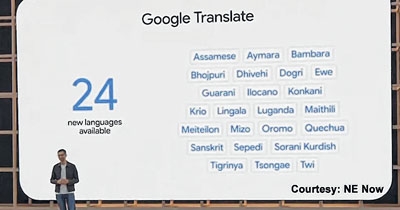Google Translate adds 24 languages and dialects, including Manipuri
|

Washington, May 12
Manipuri (Meiteilon) and Mizo languages are among the 24 languages which have been added to Google Translate language translation tool. Translate currently covers a total of 133 languages used around the world.
New Indian languages being introduced include Meiteilon (Manipuri), Mizo, Assamese, Bhojpuri, Sanskrit, Dogri, Konkani and Maithili.
Google is also adding Quechua (Peru, Bolivia, Ecuador), Guarani (Paraguay and Bolivia, Brazil and Argentina), and Aymara (Bolivia, Peru, and Chile) to the service for the first time, as well as an English-based Dialect Krio (Sierra Leone).
On May 11, Google Translate users will start getting these new languages, with all users having access by the end of the week.
The list of languages also includes Ewe (Ghana and Tongo), Kurdish (Iraq), Sepedi (South Africa), Twi (Ghana), Oromo (Ethiopia and Kenya), Tsonga (Eswatini, South Africa, Zimbabwe and Mozambique).
According to the company, more than 300 million people speak these languages as their first or second language. It further added that these languages are also the first ones added by Google utilising a translation known as Zero-Shot Machine translation, a learning model that translates any test into another language by just viewing the texts.
Full list of 24 new languages added to Google Translate
Meiteilon (Manipuri) (used by about two million people in North East India)
Mizo (used by about 830,000 people in North East India)
Assamese (used by about 25 million people in North East India)
Aymara (used by about two million people in Bolivia, Chile and Peru)
Bambara (used by about 14 million people in Mali)
Bhojpuri (used by about 50 million people in northern India, Nepal and Fiji)
Dhivehi (used by about 300,000 people in the Maldives)
Dogri (used by about three million people in northern India)
Ewe (used by about seven million people in Ghana and Togo)
Guarani (used by about seven million people in Paraguay and Bolivia, Argentina and Brazil)
Ilocano (used by about 10 million people in northern Philippines)
Konkani (used by about two million people in Central India)
Krio (used by about four million people in Sierra Leone)
Kurdish (Sorani) (used by about eight million people, mostly in Iraq) Lingala, used by about 45 million people in the Democratic Republic of the Congo, Republic of the Congo, Central African Republic, Angola and the Republic of South Sudan
Luganda (used by about 20 million people in Uganda and Rwanda)
Maithili (used by about 34 million people in northern India)
Oromo (used by about 37 million people in Ethiopia and Kenya)
Quechua (used by about 10 million people in Peru, Bolivia, Ecuador and surrounding countries)
Sanskrit (used by about 20,000 people in India)
Sepedi (used by about 14 million people in South Africa)
Tigrinya (used by about eight million people in Eritrea and Ethiopia)
Tsonga (used by about seven million people in Eswatini, Mozambique, South Africa and Zimbabwe).
Courtesy Wion